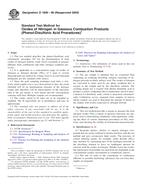We need your consent to use the individual data so that you can see information about your interests, among other things. Click "OK" to give your consent.
ASTM D1608-98(2009)
Standard Test Method for Oxides of Nitrogen in Gaseous Combustion Products (Phenol-Disulfonic Acid Procedures)
STANDARD published on 1.3.2009
The information about the standard:
Designation standards: ASTM D1608-98(2009)
Note: WITHDRAWN
Publication date standards: 1.3.2009
SKU: NS-17831
The number of pages: 6
Approximate weight : 18 g (0.04 lbs)
Country: American technical standard
Category: Technical standards ASTM
The category - similar standards:
Annotation of standard text ASTM D1608-98(2009) :
Keywords:
combustion sources, emissions, EPA Method 7, Method 7, oxides of nitrogen, phenol-disulfonic acid procedure, stack emissions, total oxides of nitrogen, Atmospheric analysis, Emission testing--stacks and flues, Gaseous environments, Nitrogen oxides, Phenol-disulfonic acid procedures, Spectrophotometry--absorption, ICS Number Code 71.040.40 (Chemical analysis)
Additional information
| Significance and Use | ||||||||||||
|
This test method provides a means to measure the total nitrogen oxides (NOx) content of gaseous emissions for purposes such as determining compliance with regulations, studying the effect of various abatement procedures on NOx emissions, and checking the validity of instrumental measurements. |
||||||||||||
| 1. Scope | ||||||||||||
|
1.1 This test method describes the phenol-disulfonic acid colorimetric procedure (1)2 for the determination of total oxides of nitrogen [nitrous oxide (N2O) excepted] in gaseous effluents from combustion and other nitrogen oxidation processes. 1.2 It is applicable to a concentration range of oxides of nitrogen as nitrogen dioxide (NO2) of 5 ppm to several thousand parts per million by volume (four to several thousand milligrams per dry standard cubic metre). 1.3 Since the grab sampling technique used takes a relatively small sample over a very short period of time, the result obtained will be an instantaneous measure of the nitrogen oxides and, therefore, will be representative of the emissions only if the gas stream is well mixed and the concentration constant with time. Multiple samples are recommended. 1.4 The values stated in SI units are to be regarded as standard. The SI equivalents are in parentheses and may be approximate. 1.5 This standard does not purport to address all of the safety concerns, if any, associated with its use. It is the responsibility of the user of this standard to establish appropriate safety and health practices and determine the applicability of regulatory limitations prior to use. (For more specific safety precautionary information see 8.5 and Section 3.) |
||||||||||||
| 2. Referenced Documents | ||||||||||||
|
Similar standards:
Historical
1.6.2006
Historical
1.6.2013
Historical
1.2.2006
Historical
1.10.2012
Historical
1.2.2012
Historical
1.5.2014
We recommend:
Technical standards updating
Do you want to make sure you use only the valid technical standards?
We can offer you a solution which will provide you a monthly overview concerning the updating of standards which you use.
Would you like to know more? Look at this page.



 ASTM D6069-01(2006)..
ASTM D6069-01(2006).. ASTM D6143-13
ASTM D6143-13 ASTM D6174-01(2006)..
ASTM D6174-01(2006).. ASTM D6328-12
ASTM D6328-12 ASTM D6348-12e1
ASTM D6348-12e1 ASTM D6656-14a
ASTM D6656-14a
 Cookies
Cookies
